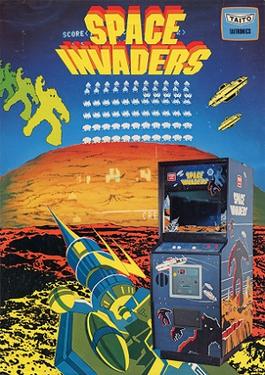
Space Invaders is a 1978 shoot 'em up arcade video game, developed and released by Taito in Japan and licensed to Midway Manufacturing for overseas distribution. Commonly considered to be one of the most influential video games of all time, Space Invaders was the first fixed shooter and set the template for the genre. The goal is to defeat wave after wave of descending aliens with a horizontally moving laser cannon to earn as many points as possible.
Shoot 'em ups are a sub-genre of action games. There is no consensus as to which design elements compose a shoot 'em up; some restrict the definition to games featuring spacecraft and certain types of character movement, while others allow a broader definition including characters on foot and a variety of perspectives.
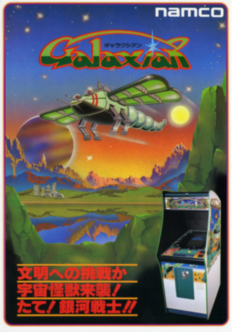
Galaxian is a 1979 fixed shooter arcade video game developed and published by Namco. The player assumes control of the Galaxip starfighter in its mission to protect Earth from waves of aliens. Gameplay involves destroying each formation of aliens, who dive down towards the player in an attempt to hit them.

Stargate is a side-scrolling shooter game released for arcades in 1981 by Williams Electronics. Created by Eugene Jarvis and Larry DeMar, it is a sequel to Defender which was released earlier in the year. It was the first of only three productions from Vid Kidz, an independent development house formed by Jarvis and DeMar. Some home ports of Stargate were renamed to Defender II for legal reasons.
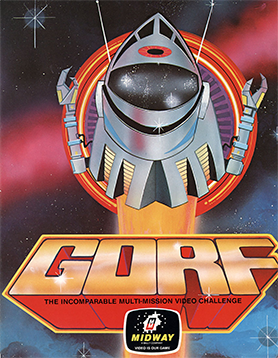
Gorf is an arcade video game released in 1981 by Midway Manufacturing, whose name was advertised as an acronym for "Galactic Orbiting Robot Force". It is a fixed shooter with five distinct levels, the first of which is based on Space Invaders and another on Galaxian. The game makes heavy use of synthesized speech for the Gorfian robot which taunts the player, powered by the Votrax speech chip. Gorf allows the player to buy two additional lives per quarter before starting the game, for a maximum of seven lives.

Space Hulk is a 1993 real-time tactical video game for MS-DOS, Amiga and PC-98. The game was based on Games Workshop's 1989 board game of the same name. Set in the fictional Warhammer 40,000 universe, the player directs squads of Space Marines, genetically enhanced armoured soldiers, in their missions to protect the human race from deadly aliens. Space Hulk was developed and published by Electronic Arts, with support from Games Workshop.

Communist Mutants from Space is a fixed shooter video game programmed by Stephen H. Landrum for the Atari 2600 with the Starpath Supercharger cassette accessory. It was published in 1982 by Starpath. The game is similar to Galaxian, adding a variety of gameplay-changing options.
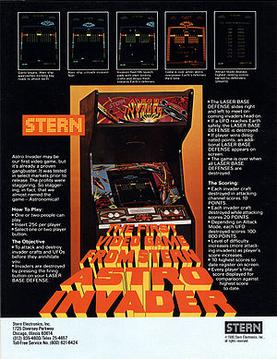
Astro Invader, originally released in Japan as Kamikaze lit. Divine Wind, is an arcade fixed shooter developed by Konami, and the first arcade game published by Stern Electronics. Astro Invader was ported to the Emerson Arcadia 2001 in 1982.
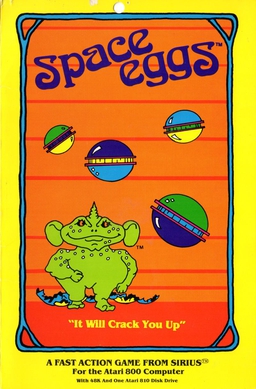
Space Eggs is a fixed shooter video game for the Apple II computer programmed by Nasir Gebelli and published by Sirius Software in 1981. An Atari 8-bit family port by Dan Thompson was released the same year. Space Eggs is an unofficial version of the arcade video game Moon Cresta.
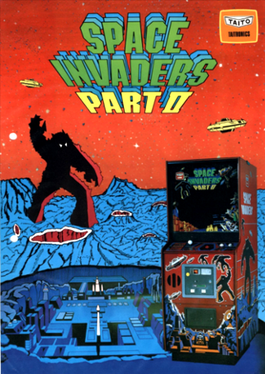
Space Invaders Part II is a 1979 fixed shooter arcade video game developed and published by Taito. In North America, it was distributed by Midway Games as Space Invaders Deluxe. It is the sequel to Space Invaders (1978). The player controls a laser base that must destroy formations of descending aliens, while avoiding their projectiles. New features have been added, such as aliens that split into two when shot, an increased high score limit with the player able to save their name as initials, and short cutscenes in-between stages. It runs on the Taito 8080 arcade system.

Space Fever is a 1979 arcade game by Nintendo R&D2. Some sources claim that Ikegami Tsushinki also did programming work on Space Fever. It was released in both monochrome and color versions. The gameplay is similar to Space Invaders, which had been released by Taito in 1978. In America, the game was distributed by Far East Video.
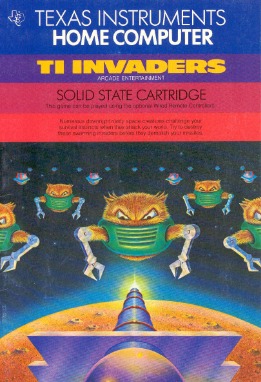
TI Invaders is a fixed shooter video game published by Texas Instruments in 1981 for the TI-99/4A home computer. The game is a Space Invaders clone where the goal is to shoot all of the aliens before they reach the bottom of the screen. TI Invaders is part of the TI Arcade Game Series which includes Tombstone City: 21st Century and Car Wars.
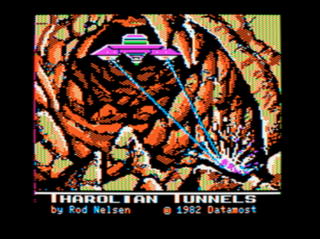
Tharolian Tunnels is a fixed shooter for the Apple II family of computers programmed by Rod Nelsen and published by Datamost in 1982. The game is similar to Space Invaders.

X-COM: Enforcer is the sixth game in the X-COM series, but takes place in a time line separate to that was established by the first four games of the series. Enforcer is an action third-person shooter without the strategy game elements of previous games. It was the last game released in the series until Firaxis Games' 2012 reboot.

Space Invaders Extreme is a re-vamped incarnation of the classic arcade game Space Invaders. The DS and PSP versions were released to mark the 30th anniversary of Space Invaders which saw its original arcade release in 1978. An HD version of the game has been remastered by Backbone Entertainment for Xbox Live Arcade with new four-player multiplayer modes and visualizer backgrounds by Jeff Minter, it was released on 6 May 2009 as a wrap-up to the 30th anniversary. The game is played at a fast pace with an electronic soundtrack and sound effects.

Space Gun is a 1990 first-person shooter arcade game released by Taito. The game is set aboard a crippled space station that has been overrun by hostile alien creatures. The objective is to rescue human crew members while destroying the alien creatures. The game lets the player shoot limbs off the creatures, resulting in blood splatters.

Heiankyo Alien, known as Digger in North America, is a maze video game created by The University of Tokyo's Theoretical Science Group (TSG) in 1979. The game was originally developed and released as a personal computer game in 1979, and was then published by Denki Onkyō Corporation as an arcade game in November 1979. In 1980, the arcade game was released in North America as Digger by Sega-Gremlin, with minor changes in appearance.

Cosmic Guerilla is a fixed shooter arcade video game developed by Universal and released 1979. A ZX Spectrum port was published by Crystal Computing in 1983.

Falsion is an on-rail 3D shoot-'em-up produced by Konami that was released for the Family Computer Disk System in 1987. It is one of the few games compatible with the Famicom 3D System peripheral.

Call to Arms is a 1982 computer wargame published by Sirius Software.



















